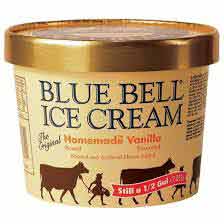Chicken and ice cream don’t have much in common. But the food poisoning outbreaks linked Foster Farms chicken and Blue Bell ice cream do.
 In 2013, Foster Farms was linked to a 29-state Salmonella outbreak that sickened 634 people with an especially virulent strain of Salmonella Heidelberg. Among those who became ill , was Noah Craten, an 18-month-old whose Salmonella infection created abscesses in his brain. To save his life, surgeons had to cut open his skull and remove them.
In 2013, Foster Farms was linked to a 29-state Salmonella outbreak that sickened 634 people with an especially virulent strain of Salmonella Heidelberg. Among those who became ill , was Noah Craten, an 18-month-old whose Salmonella infection created abscesses in his brain. To save his life, surgeons had to cut open his skull and remove them.
Noah’s story was featured in the Frontline report, The Trouble with Chicken, which traced the arc of Foster Farms decade-long Salmonella problem, spotlighted the USDA’s lack of enforcement ability and begged the question who is accountable when food makes people sick.
“Companies that make and sell contaminated food should be,” said Fred Pritzker, a food safety attorney with Pritzker Hageman, who is representing the Craten family. But that’s not always the case.
Salmonella in Foster Farms chicken first started making people sick in 2004. State and federal health officials said DNA tests showed that the strain found in samples of chicken genetically match those to strain found in people who got sick. But, because the USDA said it could not force the company to recall its products, Foster Farms kept selling chicken through an outbreak that sickened 46 people, killing one of them.
USDA documents obtained by Frontline show that at the time of the outbreak, Foster Farms Hazard control plan didn’t have a plan to handle Salmonella or even identify it as a potential problem calling it a hazard “not likely to occur” even though poultry products are responsible for about 250,000 Salmonella illnesses every year. The records show Foster Farms saw a spike in Salmonella Heidelberg before the outbreak occurred.
After the outbreak, the USDA told the company to develop a plant to control Salmonella at its processing plants. Nine years later, after an outbreak that sickened more than 600 people, the agency had to make the same suggestion.
In the 2013-2014 outbreak, even after hundreds of people were sick with the same strain of Salmonella found in the chicken, Foster Farms didn’t issue a recall. Instead the company maintained that their chicken was safe if handled properly. It wan’t until 15 months into the outbreak, when the strain was found in an unopened package of chicken in the freezer of one of the people who became sick that the company issued a recall.
What does all of this have to do with ice cream?
Just as Salmonella is commonly associated with poultry, Listeria, which thrives in cold temperatures, is a associated with dairy products. In fact, dairy products are the most common source of Listeria outbreaks.
Those most at risk of Listeria infection are pregnant women, infants, small children, frail or elderly people and those with compromised immune systems. Blue Bell, the nation’s third-largest ice cream company, sells its ice cream at retail stores and to institutional customers including schools, hospitals and nursing homes, all places with concentrated at-risk populations.
Eight of the 1o people identified as part of the four-state Blue Bell Listeria outbreak so far contracted Listeria after eating Blue Bell ice cream served to them while they were hospitalized for unrelated illnesses. Three of them died.
On March 13, when state and federal health authorities announced the outbreak, all eyes turned to Blue Bell’s three production facilities one in Brenham, Texas, one in Broken Arrow, Oklahoma and one in Sylacauga, Alabama.
Health officials from all three states told Food Poisoning Bulletin that the plant were inspected regularly and that no major issues were discovered. But none of those inspections included testing for Listeria. The assumption was that Blue Bell was testing its product and its facility.
Company records turned over to the FDA after the outbreak reveal that Blue Bell was aware that Listeria had been found on non-food contact surfaces in its Oklahoma plant as far back as 2013. In fact, Listeria was isolated from samples of non-contact food surfaces five times in 2013 , 10 times in 2014, once in January 2015 and once in February 2015. Listeria was also found after the outbreak was discovered in environmental samples collected by the FDA on March 24 and March 25 2015.
The records also show the company’s testing plan, used to evaluate the efficacy of the cleaning and sanitizing program, was inadequate, according to the FDA. For example, the plan did not call for samples to be taken from food contact surfaces, lay out any preventative action needed if bacterial contamination were found, discuss how to evaluate the impact on the products produced on the affected date, call for Listeria strains to be identified or require analysis of why cleaning and sanitizing treatments meant to eliminate Listeria didn’t work.
Why wouldn’t a food company run tests on Listeria found in its facility to determine if it was a pathogenic strain? Why would it continue to use cleaning procedures that weren’t working? Why would it continue to make and sell product as a Listeria problem in its facility worsened?
For Blue Bell, like Foster Farms, the answer is because it could.




